Thoroughbreds prove their worth as brave and dependable police mounts.
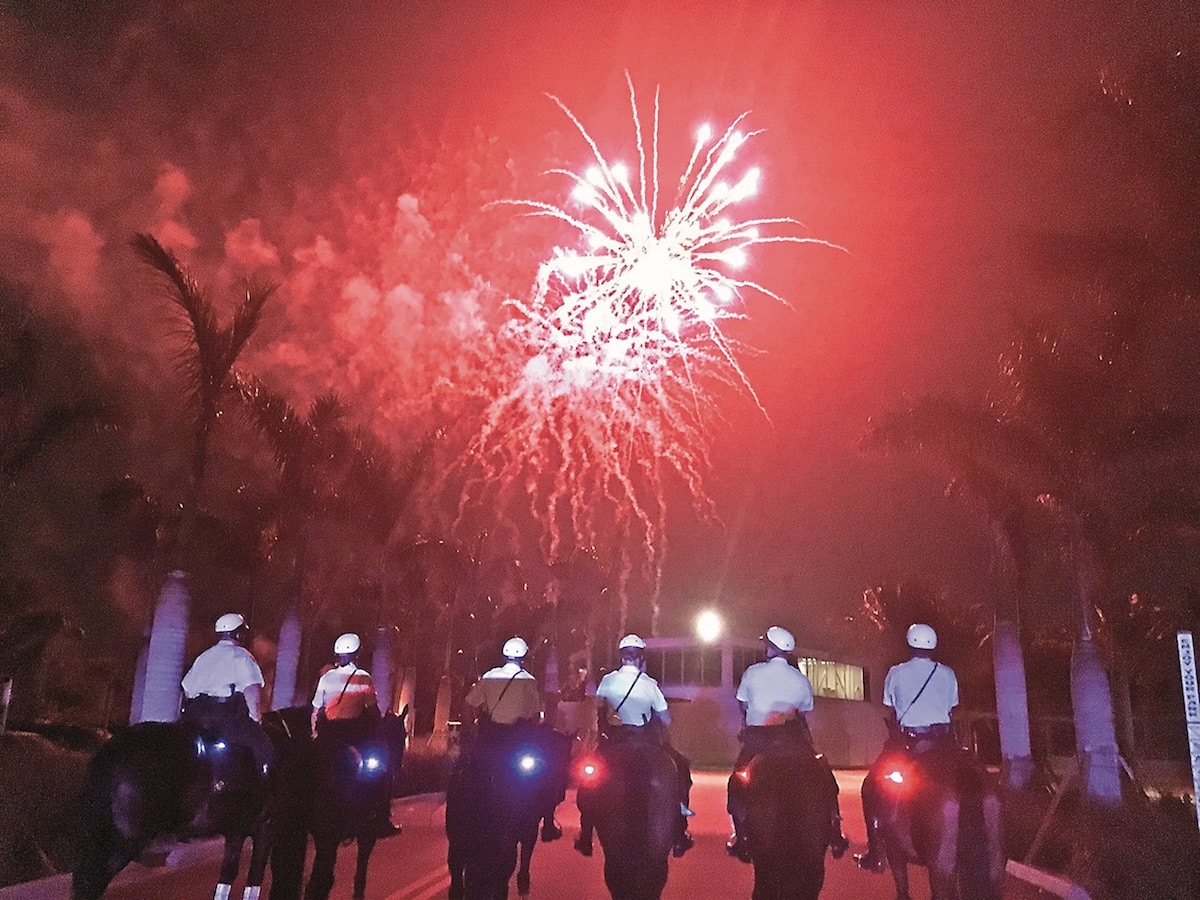
OTTBs on the Sarasota Sheriff’s Office Mounted Unit, along with their non-OTTB counterparts, are confident enough to handle the most explosive of situations. Courtesy Sgt. Chris Laster
He thought the party was for him. The retired racehorse, named Pacific, and seven of his U.S. Park Police (USPP) equine cohorts patrolled the perimeter of an audience gathered at the Lincoln Memorial, in Washington. Concerts the Sunday before President Obama’s 2009 inauguration were underway, and as the day grew later, so did the crowd’s excitement … and size.
Just as the number of concertgoers reached its peak — an estimated 400,000 on this brutally cold January day — dispatchers notified the unit’s sergeant about a medical emergency down by the Memorial reflecting pool. Parting the masses with an emergency vehicle or with officers on foot would not be feasible; the crowd was simply too thick, and all eyes were focused on the stage, not on the direction from which officers would be approaching.
The mounted unit, with its unique visibility and maneuverability, needed to move and do so quickly.
Officer Mariea Sabaté, now lead instructor with the USPP Mounted Unit, was riding Pacific that day and recalls what happened next: “They needed a horse that was going to take the lead that would walk quietly and not jig, because you’re going to be pushing up against people — not in a mean way, but because you have to get through. My commander, my lieutenant at the time, looked at me and said, ‘Can he do this?’ and I said, ‘Yes he can.’ So she said, ‘Go.’ ”
Sabaté and the big bay Thoroughbred stepped boldly into the fray.
“There was this wave of humanity, and Pacific was so quiet and so peaceful,” she said. “I was leading a squad of eight, and they all lined up behind me and in we went. He was perfect. He loved the crowds and loved that kind of situation, and it didn’t faze him in the least. He wouldn’t kick, even though there were people all over him.”
It turns out the emergency was a false alarm, but the day’s challenges weren’t over yet. Once the squad was in, it needed to remain there until the celebration ended and the crowds dispersed. The officers lined up side-by-side under a tree and waited.
“People were cheering and jumping up and down,” Sabaté says. “And Garth Brooks got to the song ‘Shout,’ and you have hundreds of thousands of people throwing their hands up in the air … it kind of wiped out the line. The horses lost it … except Pacific. He was just loving it! He stood still, like a rock, and was watching the other horses, like, ‘Where are you going, guys?’
“I dropped my reins, crossed my arms and watched this other rider who was dealing with her (spooking) draft horse,” she chuckles. “If my horse could’ve been smiling, he would’ve, (as if to say) ‘It’s great!’ It was like the people were all there for him.”
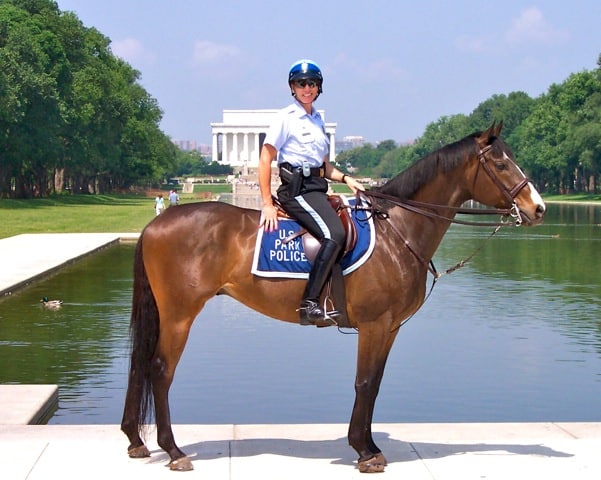
During his tenure with the U.S. Park Police, OTTB Pacific thrived in crowd situations, says his rider, Officer Mariea Sabaté. Photo by Dep. Chief Jackie Burks/Courtesy Mariea Sabate
Pacific Blackout “Pacific” (Fire Maker — Milaoshu, by Fappiano)
1997 dark bay Florida-bred gelding (now deceased)
12 starts, $29,680
U.S. Park Police Mounted Unit
Four Shoes on the Ground
Roughly a thousand miles away and eight years later, a different type of challenge awaits four Thoroughbreds serving on the Sarasota County Sheriff’s Office Mounted Unit, on Florida’s Gulf Coast. These animals work year-round, as the USPP horses do, also dealing with tourists, but in a much smaller city with two distinct busy seasons: Christmas and Spring Break.
To understand Thoroughbreds’ suitability for police work, it’s important to understand the role of mounted patrol units. Sgt. Chris Laster, supervisor of the Sarasota unit, which is a part of the agency’s Special Operations Bureau, says its function is to be high-profile and high-visibility — both to deter crime and be accessible for responding to emergencies — and to augment other units so that patrol doesn’t have to respond.
Think about mall parking lots at Christmastime; police cruisers can get caught in the traffic jams, but horses don’t. In most dense-crowd situations, as we saw with the concert on the National Mall, four horseshoes on the ground is as good as or better than four wheels and an officer on foot.
The horses are also excellent public relations for the Sarasota Sheriff’s Office, which must command respect even when vacationers largely outnumber its officers. While mounted officer pairs quietly patrol the shores during spring break (and college students walk up to pat the horses and capture selfies), they can get a good visual on any underage drinking or unruly beach behavior, printing out tickets — yes, they have a computer and printer on board — and making arrests from horseback when needed.
Now think about navigating throngs of people on windy beaches dotted with umbrellas, towels, flotation devices, beach balls and a variety of other “spooky” objects, not to mention erratic human behavior. Mounted unit horses must be unflappable, relaxed, well-conformed, athletic and able to stand patiently on the buckle, yet bravely move forward off the leg in a pinch. They must also be fit because shifts can stretch to 12 hours for any unit, though not all of it is spent in the saddle. The horses (and officers) get water breaks and time to relax in the trailer between patrol circuits, and shifts generally include barn chore time, as well.
People who consider Thoroughbreds “hot” or reactive might question how this breed could be the right fit for the job, but Laster has utter confidence in OTTBs that have good dressage basics, a nice eye, a calm demeanor and “natural ability for tolerance.” (So does Sabaté, in a matter of words, adding “brave” to that list.) In fact, four of the 10 horses in the Sarasota mounted unit stable are Thoroughbreds. The one with a known racing history is Valor, who is 23 and has been on the unit for more than a decade. Laster describes him as “calm and phenomenal, and a great horse, sensory-wise.”
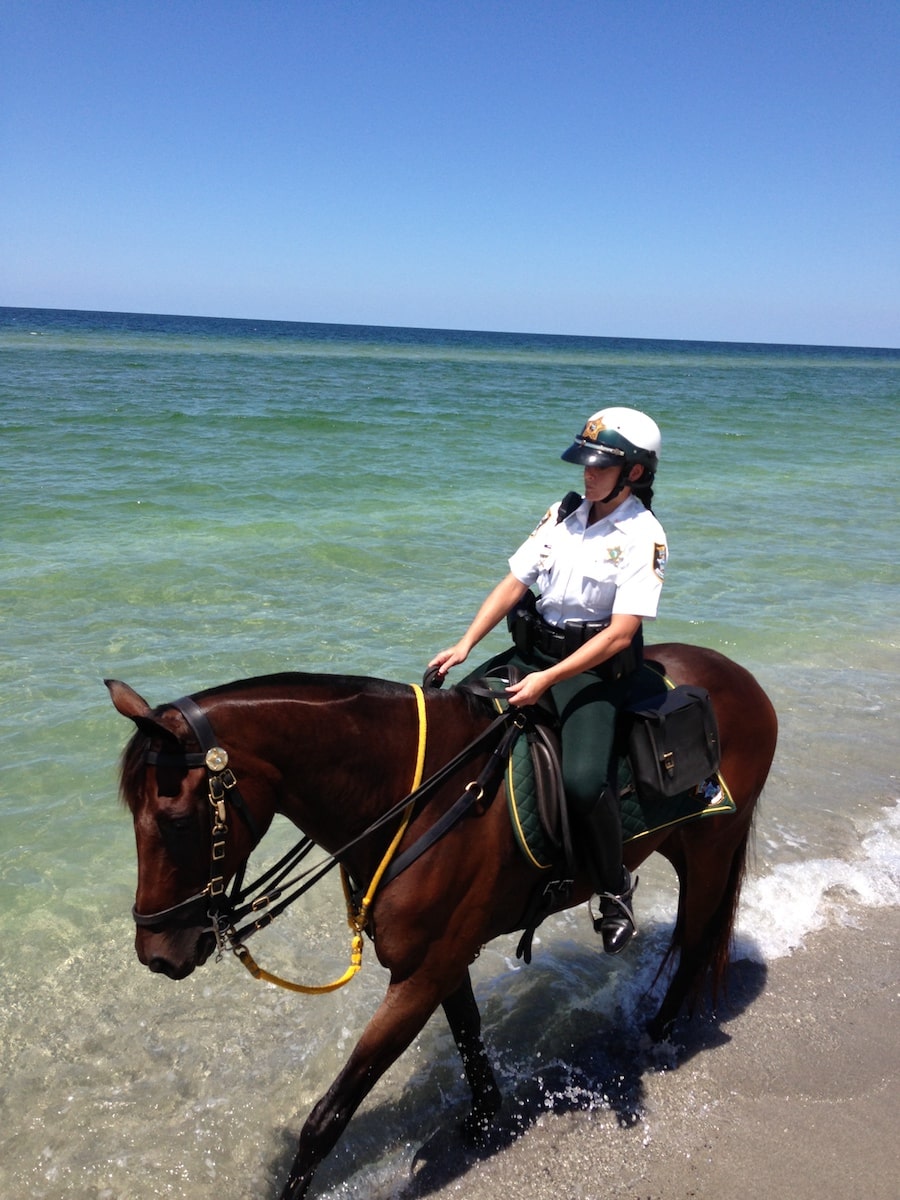
Veteran Sarasota mounted unit member, Valor, patrols the beach during spring break on Siesta Key, in Florida. Courtesy Sgt. Chris Laster
Raja’s Best Dancer “Valor” (Raja’s Best Boy — D’Or Dancer, by Medaille d’Or)
1994 dark bay Texas-bred gelding
18 starts, $7,467
Sarasota Sheriff’s Office Mounted Unit
Always, Always Forward
Laster and Sabaté agree that the key to training any great police horse is a solid dressage foundation. Because both rely on people donating horses, it means the mounts joining the force are a mixed bag, experience-wise. The USPP Thoroughbred donations have come directly from racing owners or from people retraining for other disciplines who saw the qualities of a good police horse — usually calm and brave (and not as much fans of jumping as dressage). Laster’s Thoroughbred donations have come from both private owners and at least one nonprofit animal rehoming organization.
Both trainers always have an eye and ear out for potential police horses, because their ranks are anything but static. New officers in training join, other officers retire and horse herds fluctuate as they would in any barn full of athletes with a job — managers make decisions on suitability of horses, health conditions and career length. (For instance, recently, Laster and his team retired Charlie, an unraced Thoroughbred, and former track pony, that served on the force for nearly 12 years, and Valor will be retiring within the next two years. Both will be living with their former riders.)
The best candidates, Thoroughbreds or not, already have good flatwork under their belt, but both trainers have spent (and expect to spend) time getting horses up to speed. At the USPP in Washington, 25 officers of various ages, sizes and experience are each paired with a patrol horse from a pool of about 30, housed in six barns across the city. Sabaté and her training team take turns training all the horses, including the spares, at the unit’s main training barn. In Sarasota, Laster’s herd total is 10, and he usually has eight officers on the force, so he makes sure everyone can ride all the horses, in case one of the mounts needs a few days off.
“If a Thoroughbred has had a big dressage background, it’s a very easy transition,” says Laster, reminding us that the roots of dressage are in warfare. “All the techniques of dressage were military movements, either meant to have a job function, like a capriole was meant to break down barriers, or intimidate the enemy, for example all the off-the-leg movements, as far as side-passes, leg yields, things like that, even piaffe and passage.
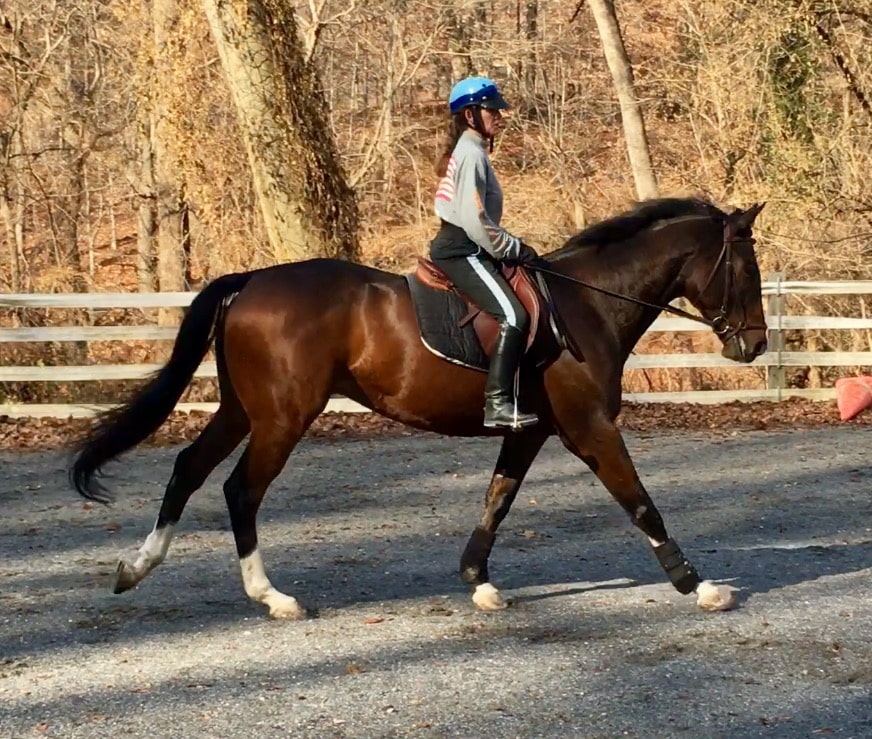
Mounted police love a Thoroughbred with a strong dressage background. Officer Katie Swarthout works Timber on the flat to hone his skills. Courtesy Mariea Sabate
“It’s meant to have a horse that’s all in the back end, light in the forehand, so the rider can use nothing but leg and (with reins in one hand be able to) use a sword,” he continues. “Now it’s more about athleticism and the basic training of the horse. It’s that structured training that really, really helps in doing our job.”
That effect of working lighter on the forehand extends horses’ police careers, says Laster, given that they spend a lot of time standing and moving (sometimes at speed) across concrete.
He and Sabaté both have taught mounted police officers and their trainers around the country (and in Laster’s case, worldwide). The main principles Laster uses are, “No. 1, the smart one’s on top,” he says, “And No. 2, it’s always forward … and forward is not just a gait, it’s a mindset. Even if the horse is concerned about something, as long as it will go forward, we can get our job done, because … as long as we can keep our bodies on a straight line, or manipulate that horse where we want it to go, we can be very functional, even if the horse is agitated.”
And ultimately, this is where Thoroughbreds really excel: having heart and going forward, say both Sabaté and Laster. “There are lots of times when we’re dealing with a huge crowd,” says Sabaté, “where Warmbloods generally want to think about it, and the Thoroughbred wants to be in the front and go.”
Laster also emphasizes example and repetition in training; the more they’re exposed to things and the more they’re ridden in the environment they’re going to be working in, the more successful they’re going to be.
After putting good flatwork on the horse, Sabaté takes new horses out in pairs or in larger groups for hacks over 19 miles of trails in Rock Creek Park, which is adjacent to the USPP training facility. (The horses also get to pass the National Zoo on the way). This allows them to release some energy, if they need to, and get exposure to a variety of people on foot, dogs (she says OTTBs are great with off-leash dogs, for whatever reason) and different recreational activities.
Laster’s horses also always patrol in pairs, with new horses riding out with “a steady Eddie,” who can be a good influence in any potentially frightening street situations, he says. But, first and foremost, the horse has to be mature. One of his latest Thoroughbred additions spent a year out in a field, “letting down,” with only some longeing training, until he was 5, which is when Laster says a well-suited horse’s brain and body are generally ready to handle the rigors of police training and work.
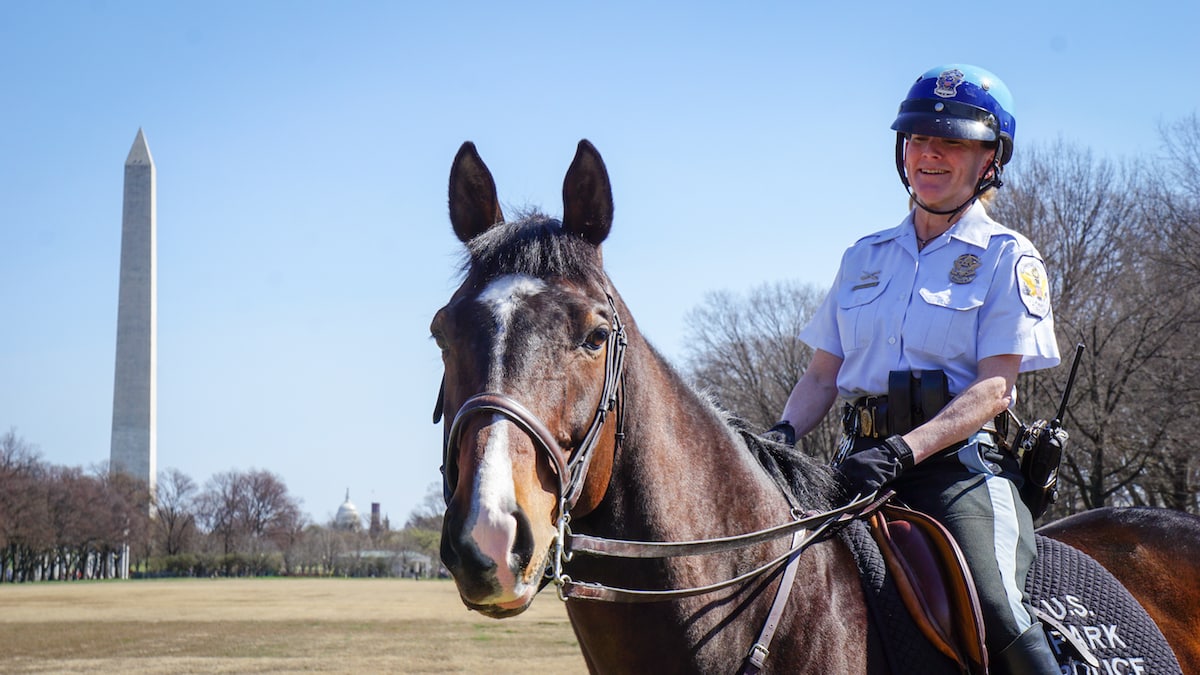
Timber, shown here with Officer Katie Swarthout, is a 6-year-old Thoroughbred on the U.S. Park Police force who never made it to the track due to an injury. Courtesy The Horse Staff
Racehorses and Police Work: A Unique Exacta
Something racehorses have in their favor when it comes to police work is their history of exposure to many sensory experiences that other horses might not have had, particularly crowds and noise.
“Shanigan,” who had 82 starts over his racing career, is a good example of a racehorse who had seen it all. He came to the USPP in April of his 10-year-old year. Upon arriving in Washington, he had three months to prepare for one of the city’s most exciting — and, arguably, explosive — occasions for police horses: The Fourth of July.
Preparation amounted to copious flatwork and learning one of the very important basics of being a police horse. “His hardest thing to learn was to stand still when he didn’t want to,” says Sabaté. “But he accepted all the new experiences. I was confident enough that he could handle Fourth of July, and we’re talking downtown Washington D.C., with the fireworks, and he was bored silly.”
Subsequently, Shanigan was in high-demand among the officers, working detail at the 2012 Democratic National Convention, held in Charlotte, North Carolina, and several other high-profile events. His rider has since retired from the force, but Shanigan remains a capable, fit spare in work in the USPP training barn.
One of police horses’ important jobs involves not only navigating through a thick crowd but also moving the crowd itself. This happens in cases of riot control or when people need to be moved for an emergency vehicle’s passage. Laster and Sabaté both feel this is another place the Thoroughbred excels.
“We’re going to use the herd nature of the animal to do crowd control formations,” says Laster. “We take our stronger horses up front, and even though the other horses may not like what they’re doing, they’ll move as a team to do the work.”
So, while you want a horse used for most disciplines to yield to pressure if you push on their chest or shoulder or wave your arms, police horses need to move forward bravely, and steadily, to manipulate the placement of the people without crushing them.
Sabaté has seen Thoroughbreds, even besides Pacific — at his very own concert of 400,000 people — boldly do this job.
“I like the fact that the Thoroughbred just wants to work,” she adds. “I’ve spent more time trying to deal with crafty Quarter Horses that will do anything to get out of work. The Thoroughbreds, in my experience, they say, “Give me a job, and I’ll do it.” You just have to take time and not force them, and let them be comfortable with their surroundings, and they’re OK.”
And while Laster says he does love a good Quarter Horse, they rarely come in the size he needs for his officers. An average officer suited up in all his or her gear, with saddle and saddle bag contents, weighs well over 200 pounds, so both Laster and Sabaté look for bigger mounts, which can be found among the Thoroughbreds. The USPP will take mares or geldings, 15.3 and up, while Sarasota seeks geldings 16 hands and up.
Just as not every mounted officer is suited to a Thoroughbred mount, not every retired racehorse is suited to serve on a patrol unit. But many do have what it takes: The right temperament, paired with time and training.
Some are clearly suited for the job from the get go. Navigator, the newest Thoroughbred addition to the Sarasota force, started with a good foundation of flatwork after that year letting down and did a stellar job during his first Christmas season in the shopping districts and malls in Sarasota County, says Laster. He’s also taking quickly to Spring Break patrol on Siesta Key.
But there was another, earlier sign he was right for the job. He has a distinctive marking on his hindquarters in the shape of the agency’s shoulder patch — a shield.
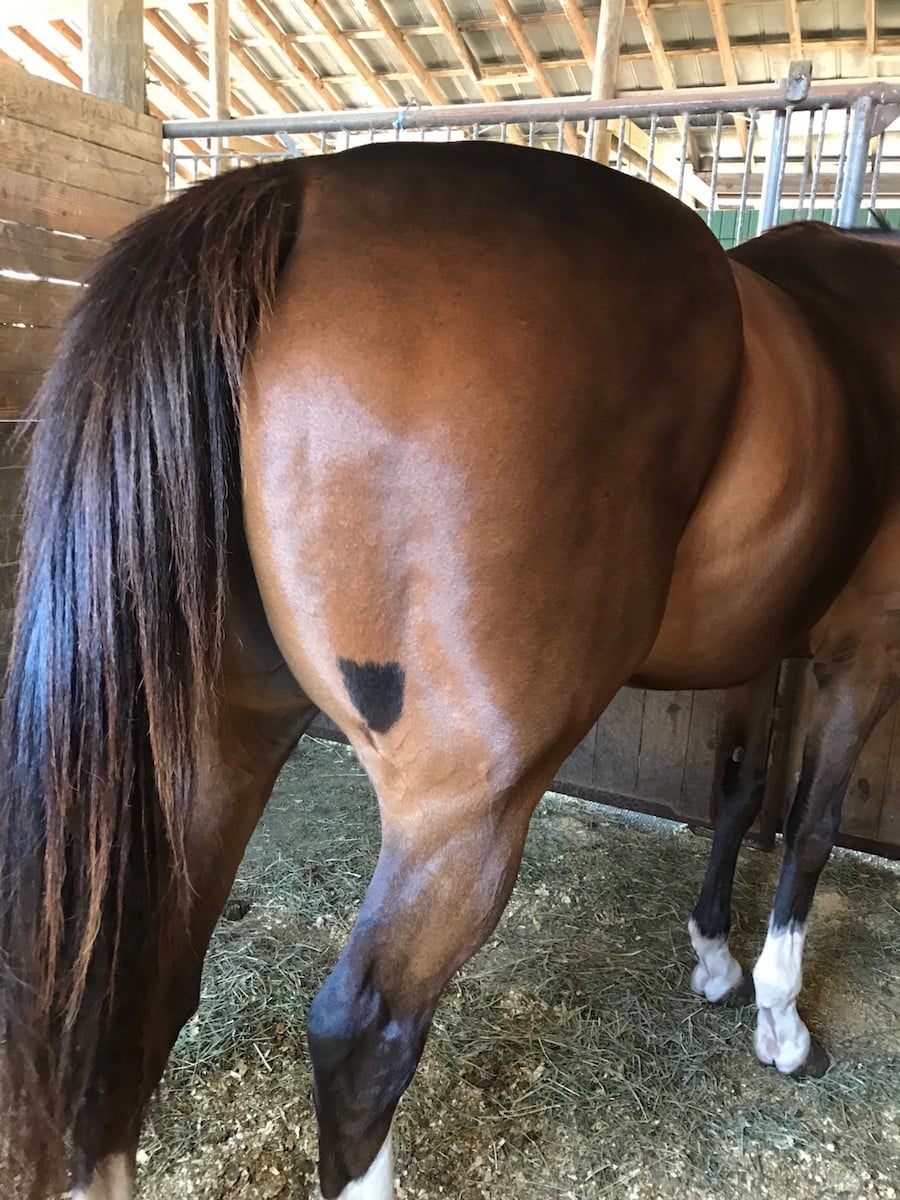
Sarasota mounted unit’s newest Thoroughbred, Navigator, seems born for the job. He sports a shield-shaped marking on his hindquarters. Courtesy Sgt. Chris Laster
Perfect Navigator “Navigator” (Henrythenavigator — Perfect Cause by Giant’s Causeway)
2011 Bay Kentucky-bred Horse
Unraced
Sarasota Sheriff’s Office Mounted Unit
Name Games
None of the Thoroughbreds on the two units described here go by their exact Jockey Club names.
When Mariea Sabaté, lead instructor with the U.S. Park Police Mounted Unit, is out patrolling in Washington, D.C., she says there’s one question that seems critical to the asker’s experience. “They come screaming at you from across the (National) Mall, and you think there’s a problem,” she says. “The problem is they must know his name. But in some cases the names are too long, too difficult, strange, inappropriate, so we will end up changing the name to something that we want to say 500 times a day.”
So, “Volo Del Vento,” (Wiseman’s Ferry — Secret Breeze, by Secret Hello) became “Da Vinci” and “Awesome Jake” (Satchmo’s Band — Shelly’s Gold, by Goldlust) is, simply, “A.J.” And while “Dude Again” would’ve been an amusing way to answer the perennial question, that horse has been renamed “Shanigan,” or “Shanny.”
This article was originally published in the Spring 2017 issue of Off-Track Thoroughbred Magazine, the only publication dedicated to the Thoroughbred ex-racehorse in second careers. Want four information-packed issues a year delivered to your door or your favorite digital device? Subscribe now!

